We get to test all sorts of craft at Fishing Monthly from six-figure offshore boats through to sub-grand paddlecraft. Every so often one comes along that bridges the gap between genres.
That’s what the Rosco Bass Catcher does – bridge the gap between a canoe and a tinnie. It looks like a canoe, but performs a lot like a boat. And the best bit is that you can launch it in places that tinnies are a pain in the bum to get into the water.
So, for this reason, we chose a saltwater, landlocked lake on the Gold Coast. There are no boat ramps in it, but plenty of bridges, parks and easements that allow water access. I wouldn’t have got my little Bluefin Jon Boat in there easily.
OK. I lie. I wouldn’t have gotten it in there at all.
The Bass Catcher we had to test was the staff boat of the Rosco Kedron store, therefore it was pretty specifically set up for the needs of the guys who make these boats from scratch.
The basic Bass Catcher hull is a three seater and at the top end of the capacity and length range for a canoe. It’s got a flat transom, which allows the mounting of a small petrol-powered outboard. In this case it was a Yamaha 4-Stroke 4hp.
Also fitted were a set of outriggers. Although they look a little cumbersome, these stabilisers allow you and your fishing buddy to stand up and fish with ease – a feat that takes pretty precise balance and communication on a plain canoe. If you’ve tried it, you know what I mean.
The most convenient part of the setup was a single axle boat trailer for ease of transport. Even with the outriggers fitted, the rig measures in under the 2.5m maximum road limit.
If you have access to a boat ramp, slide it straight in. If you don’t (and we didn’t), it was pretty simple to unscrew the outboard and manhandle the boat in and over the rocky edges and the fit the motor to the transom again. On the test day, this took a maximum of about 15 minutes.
So, with 4 fishing rods and 100 lures on board, we set about ‘boat testing’ on a lovely, overcast, Gold Coast morning.
With Greg ‘man-lure’ Livingstone as my wingman, I was smart enough to pick ‘front” when he asked what end I wanted to sit.
Apart from getting first crack at all of the best spots, the front seat isn’t the best place to manoeuvre a canoe – especially with an outrigger impeding a full stroke. It was Livo’s turn to be a guide and being the boss had to have SOME advantages.
After a couple of cranks on the cord, the little Yammy blurted to life and we decided to take a run around this little system and see what there was to fish.
I was quite surprised as how fast it went. It must have been 6 knots – as this was the speed limit in this system – but geez, it felt a bit faster than that.
You can attribute some of the performance to the upswept stern keel section, which keeps as much of the turbulence away from the transom section as possible. Any BASS Electric competitor knows that the less flat-backed transom in the water, the faster you go and it’s good to see that the designer of this craft has built that performance into the hull.
With the two outriggers fitted, this thing is virtually impossible to capsize. We didn’t try to do it, because of the volume of sinking tackle onboard, but when we picked a bank and started fishing, it was a no-brainer for the both of us to be able to stand up and not worry at all about capsizing the craft.
What does happen, though, when you both stand up is that you act like a couple of sails. What this craft (and any shallow drafted canoes) is no good at is keeping a drift along a bank. The only thing worse than two guys trying to fish in a canoe is one guy trying to do it himself.
We were lucky – I had the ‘man-lure’ as a guide and a well-placed paddle stroke here and there kept the drift true. If fact, when I looked back, I’m sure that Greg thought he was a Mexican bonefish guide. He had that distant look and a Buff covering his face. Not wanting to wreck his illusion, I started chucking topwaters at some of the bankside structure.
I’m sure that the sight and sound of a kilo-class bream exploding all over my white Cicada topwater shook him from his fantasies. We weren’t getting many bites in this lagoon, but what we were getting was total quality – at least by the Gold Coast’s standards.
By the time I had to jump out and take some photos, we’d put together a 5-bream limit that would have weighed around 4kg. That’s not an easy feat in that part of the world and something I’d only done once on the Gold Coast in a bass boat.
Notch up one for the Bass Catcher for getting you into spots that others find it hard to get to.
With Greg firmly back in reality and posing for some action shots for the magazine and the video (scan the QR Code hereby for a link), it was easy to see the attractiveness of this craft to more than just the anglers.
It scoots along, it’s stable, you can sail it (with a factory sail – not just by standing up in it) and it has a massive payload capacity.
In reality, a couple of normal sized anglers could load this thing up with an extra 300kg of camping gear and scoot off to somewhere even more remote than a landlocked Gold Coast Canal system and not have to come back for a week!
The 500 Bass Catcher will set you back $2,650 and the optional outriggers are yours for just over a grand more. You can get more information by visiting www roscocanoes.com.au or by calling the store on (07) 3358 9330.
SPECIFICATIONS
ROSCO Bass Catcher 500
| Length | 4.63m |
|---|---|
| Beam: | 100cm |
| Depth: | 40cm |
| Weight: | 42kg |
| Payload: | 450kg |
| Passengers: | 1-3 |
| Max hp: | 4 |
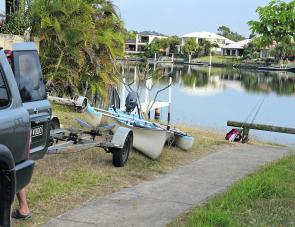
The Bass Catcher is great for getting to places you just can’t get a trailerboat.
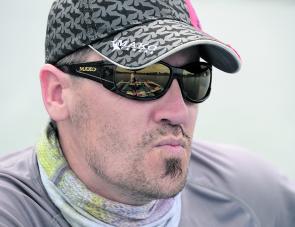
This is Greg ‘man-lure’ Livingstone in his ‘I’m a Mexican Flats Guide’ persona.

There were some cracking bream gracing the Bass Catcher on the test day.
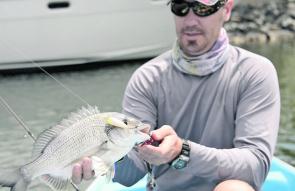
When the guide put down the paddle and grabbed the rod, results were quick to come.

Standing up is a cinch in the Bass Catcher – and that’s with either one or two anglers casting.
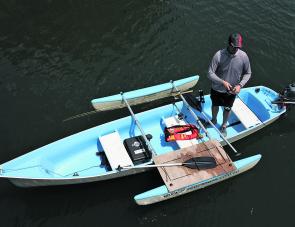
Load up all that space with come camping gear and you’re outta here. The Bass Catcher holds 320kg of payload!
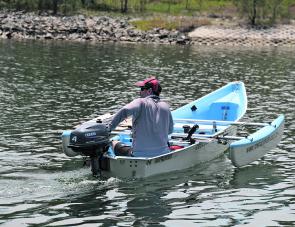
The 4hp Yamaha pushed the Bass Catcher around quite nicely at speeds up to (but not exceeding) 6 knots. That’s right, officer. Only 6 knots.




